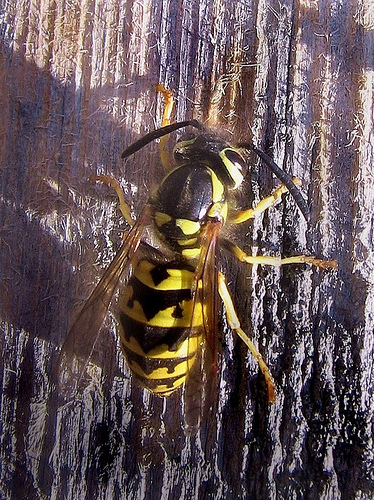“Why Are There Yellowjackets Around My Lettuce?”
By Chris Williams on August 22, 2014.
 One of our technicians got this question from a customer the other day. At first I said that doesn’t make any sense. There’s no reason why yellowjackets would hang out around lettuce plants. But then I thought about it further and realized that there are a couple of reasons why this could occur. So, Ms. Customer, here’s the answer to your question, straight from the entomologist:
One of our technicians got this question from a customer the other day. At first I said that doesn’t make any sense. There’s no reason why yellowjackets would hang out around lettuce plants. But then I thought about it further and realized that there are a couple of reasons why this could occur. So, Ms. Customer, here’s the answer to your question, straight from the entomologist:
1) The yellowjackets’ nest could be in the garden
Most of our pest yellowjackets are ground nesters, meaning that they have the typical paper-covered nest with layers of combs, but the nest is underground. The entrance hole in the soil is about the size of a nickel. Depending on the time of year (and the consequent size of the colony), there may be a lot of traffic in and out of that nest entrance, or very little. In either case, if you stand nearby and observe, you should be able to see yellowjackets entering and leaving the nest, especially on a sunny day. If there is a nest opening there, it is likely hidden under the lettuce or the foliage of other crops so be careful when harvesting.
2) The yellowjackets could be feeding on insects feeding on the lettuce
During the height of the season, yellowjackets feed primarily on other insects, collecting them to feed to larvae in the nest. If your lettuce is being attacked by insects like armyworms or corn earworms, the yellowjackets may have discovered that and they are hanging around your lettuce in order to capture the worms. In that sense, the yellowjackets are doing you and your lettuce a favor.
3) The yellowjackets may be seeking shade & moisture
On a hot, dry summer day, your lettuce plants may simply be providing a cool retreat for thirsty yellowjackets. All insects need water and those large, textured lettuce leaves may be holding dew droplets or water from your watering.
Or, there could be no logical reason at all why yellowjackets are around your lettuce! As we approach late summer, yellowjacket behavior becomes more erratic as their colonies start to break down and die. There are no new larvae developing in the nest, so the search for protein subsides. Besides insects, yellowjackets start feeding on other foods, including sweets. They also become more aggressive which is why we get so many calls at this time of year about human-yellowjacket interactions.
For more on late season yellowjacket behavior, see:
- Are Yellowjackets Declining?
- The Late Summer Yellowjacket Blues?
- Yellowjacket Nests Don’t Survive the Winter
Photo credit: wolfpix / Foter / Creative Commons Attribution-NoDerivs 2.0 Generic (CC BY-ND 2.0)